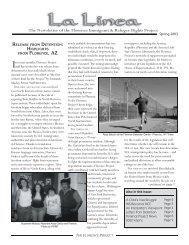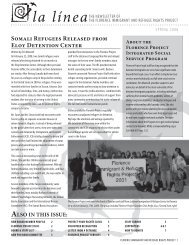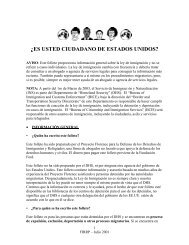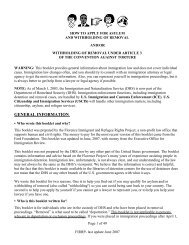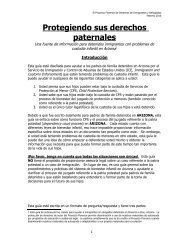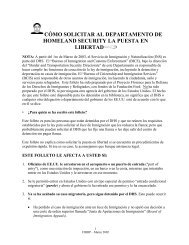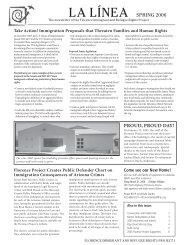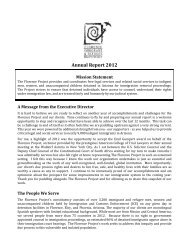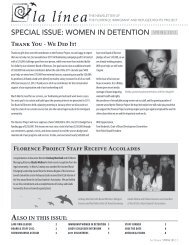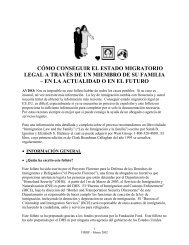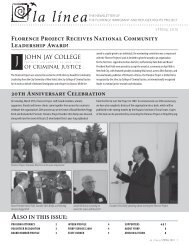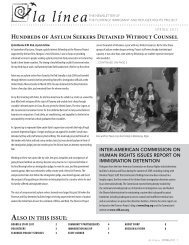quick reference chart and annotations for determining immigration ...
quick reference chart and annotations for determining immigration ...
quick reference chart and annotations for determining immigration ...
Create successful ePaper yourself
Turn your PDF publications into a flip-book with our unique Google optimized e-Paper software.
Immigrant Legal Resource Center, Florence Immigrant <strong>and</strong> Refugee Rights Project,<br />
Maricopa County Public Defender August 2012<br />
turpitude. Matter of Muceros, Index Decision (BIA 2000) (willfully shooting at inhabited dwelling<br />
house, whether occupied or not, or at occupied structure under Cal. Pen. Code § 246 is a CMT).<br />
Aggravated Felony: Crime of Violence. Divisible. An aggravated felony crime of violence<br />
requires as an element the use, attempted use, or threatened use of physical <strong>for</strong>ce against the person or<br />
property of another, or a “substantial risk” that such <strong>for</strong>ce will be used in a felonious offense. 18 U.S.C.<br />
§ 16. By careful pleading, counsel can provide <strong>immigration</strong> counsel with an argument that a particular<br />
disposition is not against the person or property of another <strong>and</strong> thus is not an aggravated felony. Counsel<br />
must not permit the record to preclude the possibility that (a) the property was unoccupied (i.e., there was<br />
not a current resident, as opposed to the current resident was not home at the time) <strong>and</strong> (b) the property<br />
was owned by the defendant. Counsel should plead to the generic language of the statute <strong>and</strong> avoid<br />
<strong>reference</strong>s to an inhabited residence or the property of another.<br />
Rationale: Regarding “against a person,” shooting at an “inhabited dwelling place” under<br />
Cali<strong>for</strong>nia law has been held a crime of violence since it “necessarily threatens the use of physical <strong>for</strong>ce<br />
against the resident.” U.S. v. Cortez-Arias, 403 F.3d 1111, 1116 (9th Cir. 2005). However, the Ninth<br />
Circuit in U.S. v. Martinez-Martinez, 468 F.3d 604 (9th Cir. 2006) distinguished the Arizona statute by<br />
finding that the definition of “residence” in ARS § 13-1211 is broader than that of a Cali<strong>for</strong>nia “inhabited<br />
dwelling house,” because it includes dwellings in which no one is currently living. There<strong>for</strong>e, the<br />
discharge of a firearm at either a residential or nonresidential structure appears to be divisible as a crime<br />
of violence against a person, since it can be committed against a structure where no one is currently<br />
living. The government will likely argue that the offense is a crime of violence under 18 U.S.C. § 16(b)<br />
as a felony that involves a “substantial risk” that <strong>for</strong>ce will be used – an issue that Martinez-Martinez did<br />
not address. However, <strong>immigration</strong> counsel may have arguments against this.<br />
Regarding the use of <strong>for</strong>ce against “property of another,” § 13-1211 includes offenses that are<br />
committed against one’s own property. Unless the record of conviction demonstrates that the offense was<br />
committed against the property of another, the offense is not a crime of violence against property. See<br />
Jordison v. Gonzales, 501 F.3d 1134 (9th Cir. 2007).<br />
Other Grounds: Firearms. Yes, deportable. Plead to an aggravated assault that doesn’t require<br />
use of firearm, or endangerment, or a weapons possession charge that does not identify the weapon as a<br />
firearm or destructive device. Better is a plea to simple possession of a weapon not identified as a<br />
firearm; see § 13-3102. See Note: Firearms.<br />
Other Grounds: Domestic Violence. Arguably the domestic violence deportation ground<br />
covers only acts against persons, not property. However, to ensure that the conviction does not cause<br />
deportability under this ground, counsel should not permit the record of conviction to establish that the<br />
property was occupied, or even controlled or owned, by a person with whom the defendant had a<br />
domestic relationship.<br />
17. Custodial Interference, ARS § 13-1302<br />
A. A person commits custodial interference if, knowing or having reason to know that the person has no<br />
legal right to do so, the person does one of the following:<br />
1. Takes, entices or keeps from lawful custody any child, or any person who is incompetent, <strong>and</strong> who is<br />
entrusted by authority of law to the custody of another person or institution.<br />
2. Be<strong>for</strong>e the entry of a court order <strong>determining</strong> custodial rights, takes, entices or withholds any child<br />
from the other parent denying that parent access to any child.<br />
Arizona Criminal Chart with Explanatory Endnote – August 2012<br />
29



